Sometimes, I look at my backyard and dream about a space where my ducks can waddle, splash, and explore safely. Creating a home for them is more than just throwing up a fence—it’s about building a cozy place where they feel happy, loved, and secure. I know that every little detail, from shade to comfy flooring, can make a world of difference for both my ducks and me.
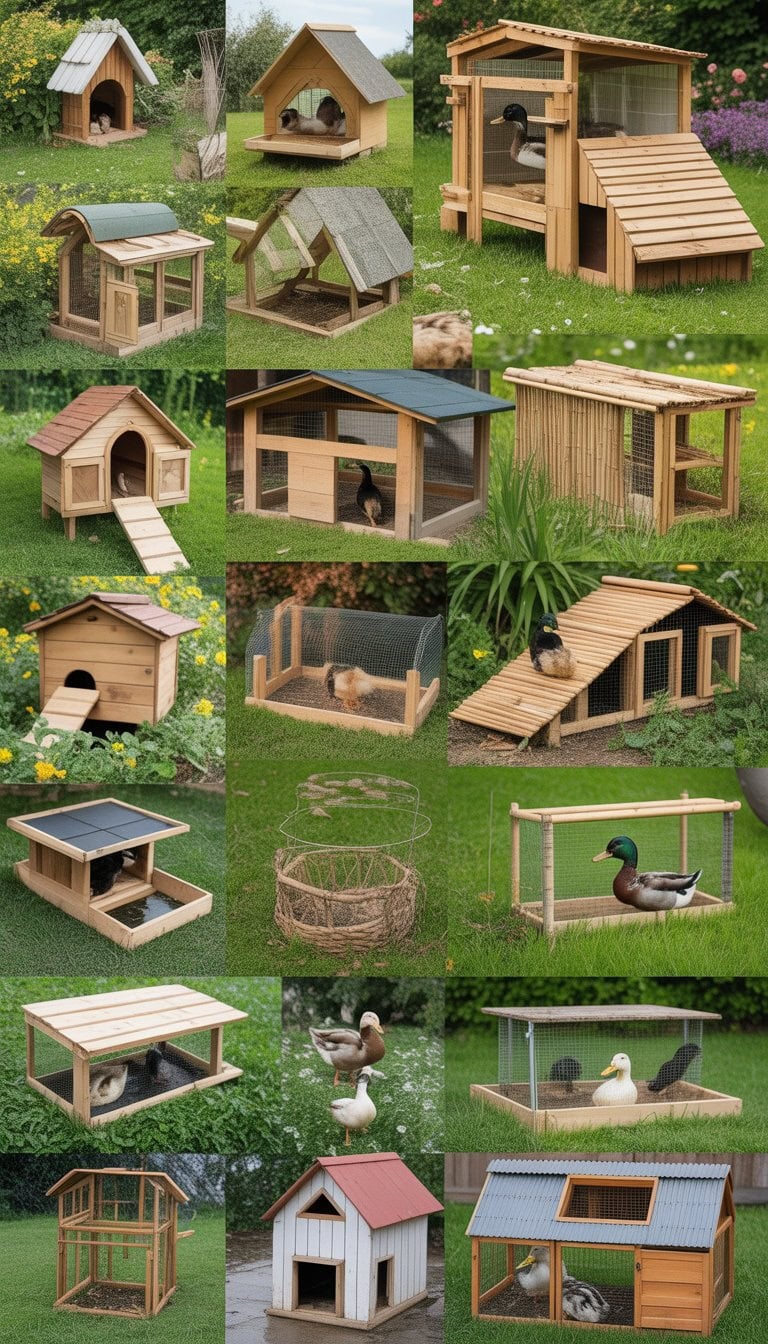
I’ve put together these 23 DIY duck enclosure ideas to help you create a lovely environment that your feathered friends—and your heart—will adore. I want you to feel the same joy and sense of accomplishment I do when watching ducks playing in a space built just for them. With a few creative ideas and a bit of effort, your backyard can become a charming, safe, and delightful home for your ducks.
Build a 300 sq ft coop with secure fencing
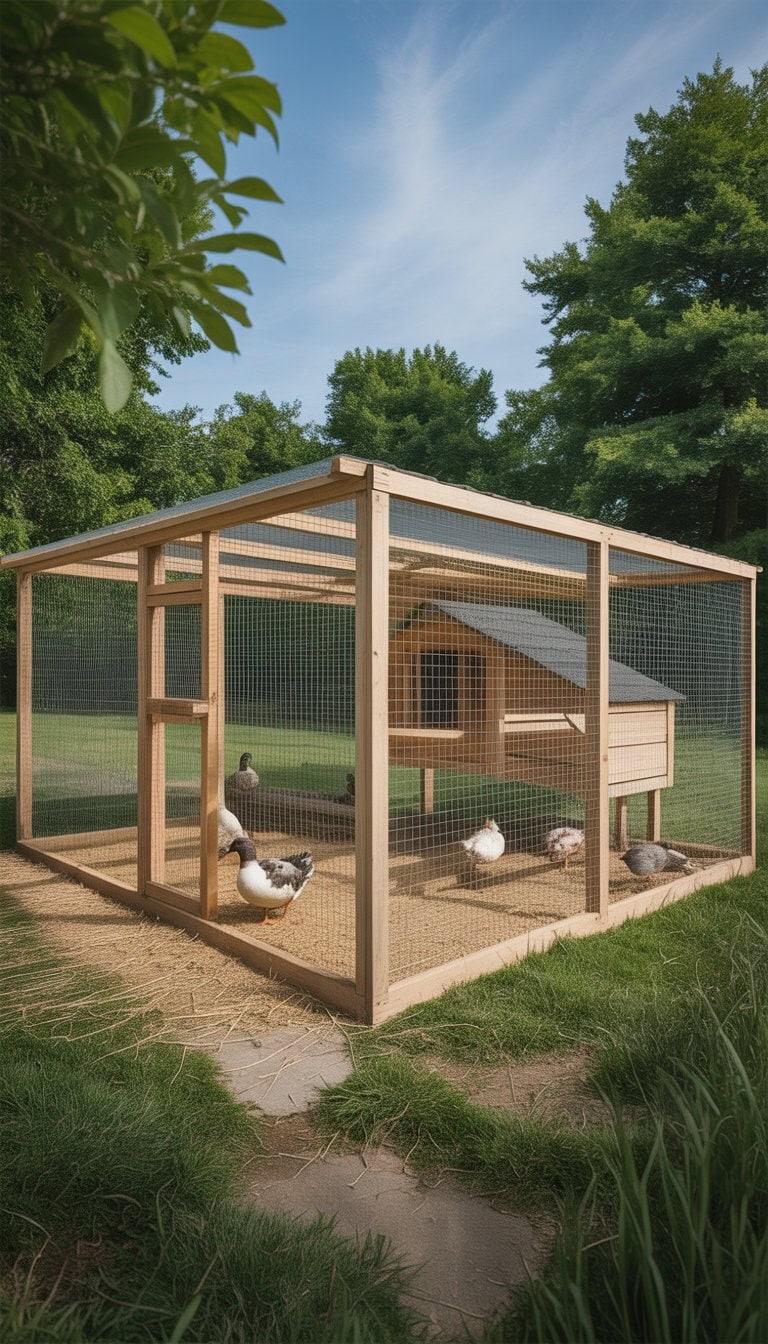
I decided to give my ducks plenty of space, so I built a 300 square foot coop. It lets them move around and keeps them happy. I used strong fencing to protect them from foxes, coyotes, and other animals that visit at night.
Adding secure fencing means I worry less. My ducks can play and rest without trouble. I found some helpful ideas about coop size and fencing from this DIY duck enclosure guide. It made planning so much easier.
Use pine bedding for easy cleaning
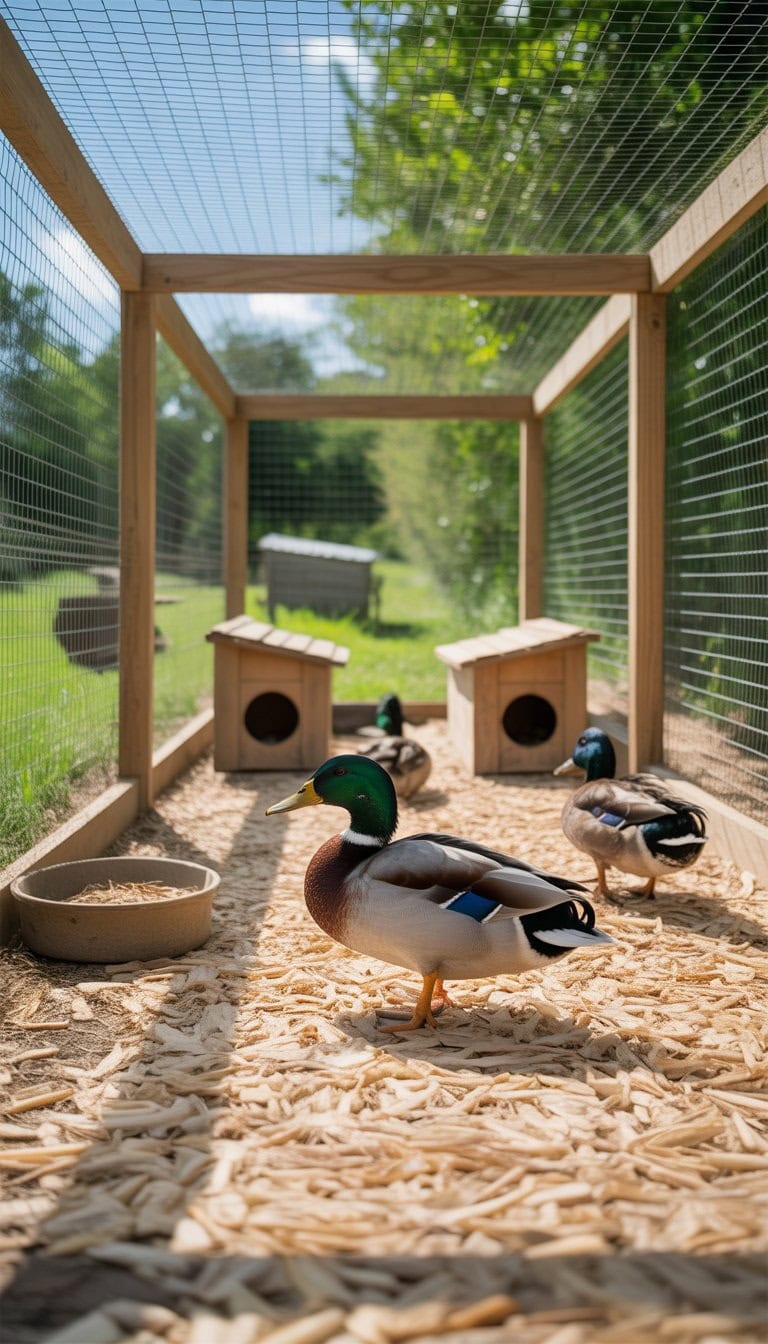
I’ve tried a lot of duck bedding, but pine shavings are my favorite for quick cleanup. They soak up moisture well and help keep duck smells down.
I lay down a thick layer, about two to three inches deep. I check the bedding every day and add new shavings if needed.
Pine bedding is easy for me to scoop out and replace. If you want things even simpler, you can use big flake pine shavings, which last longer between changes. You can see others recommend it too at this duck coop bedding guide.
Create a covered run to protect from snow and rain
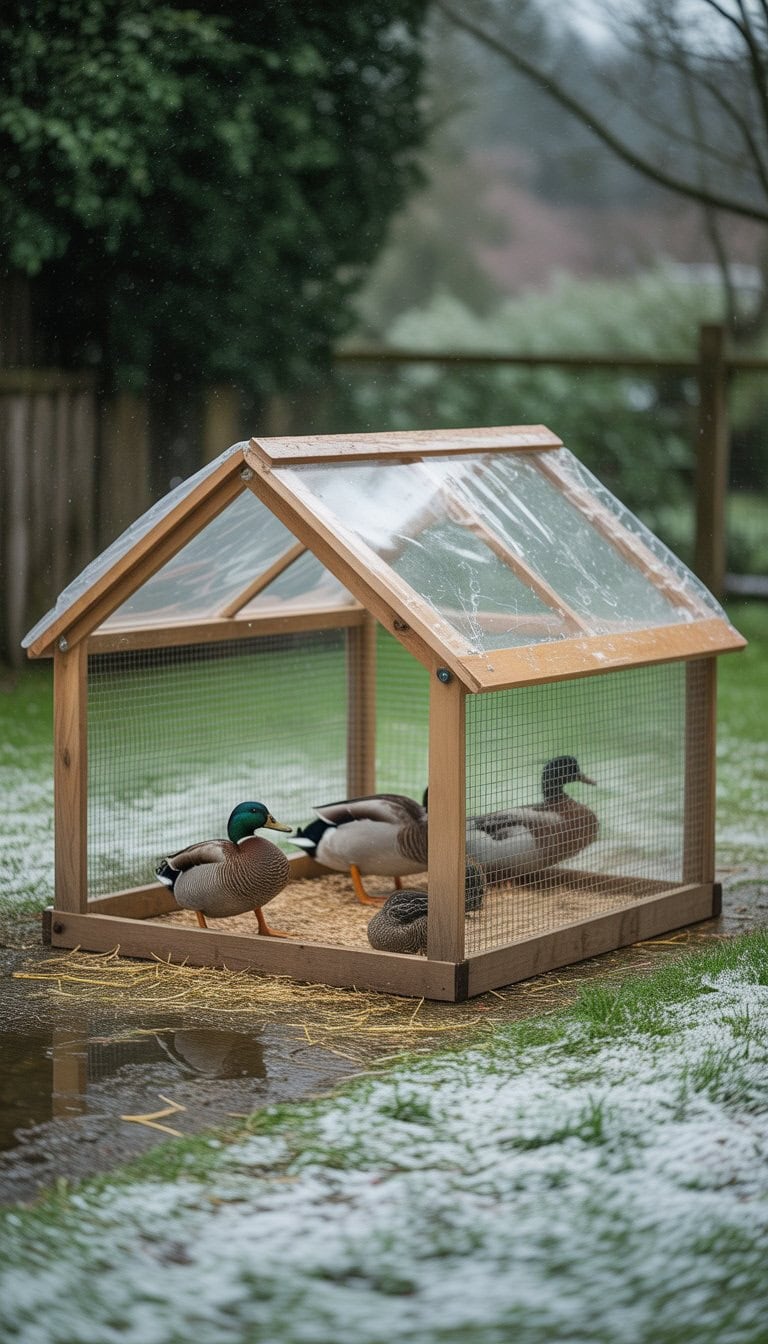
I always make sure my duck run has a good cover. Snow and rain can make the area messy and hard for ducks to walk in. A roof keeps things drier and helps the ducks stay healthy.
I use clear panels or strong netting so sunlight can still get in. Others like to build with flight netting that handles snow well, like people share here.
It’s simple, but it keeps my flock safe and happy all year.
Design an A-frame shingle roof duck house
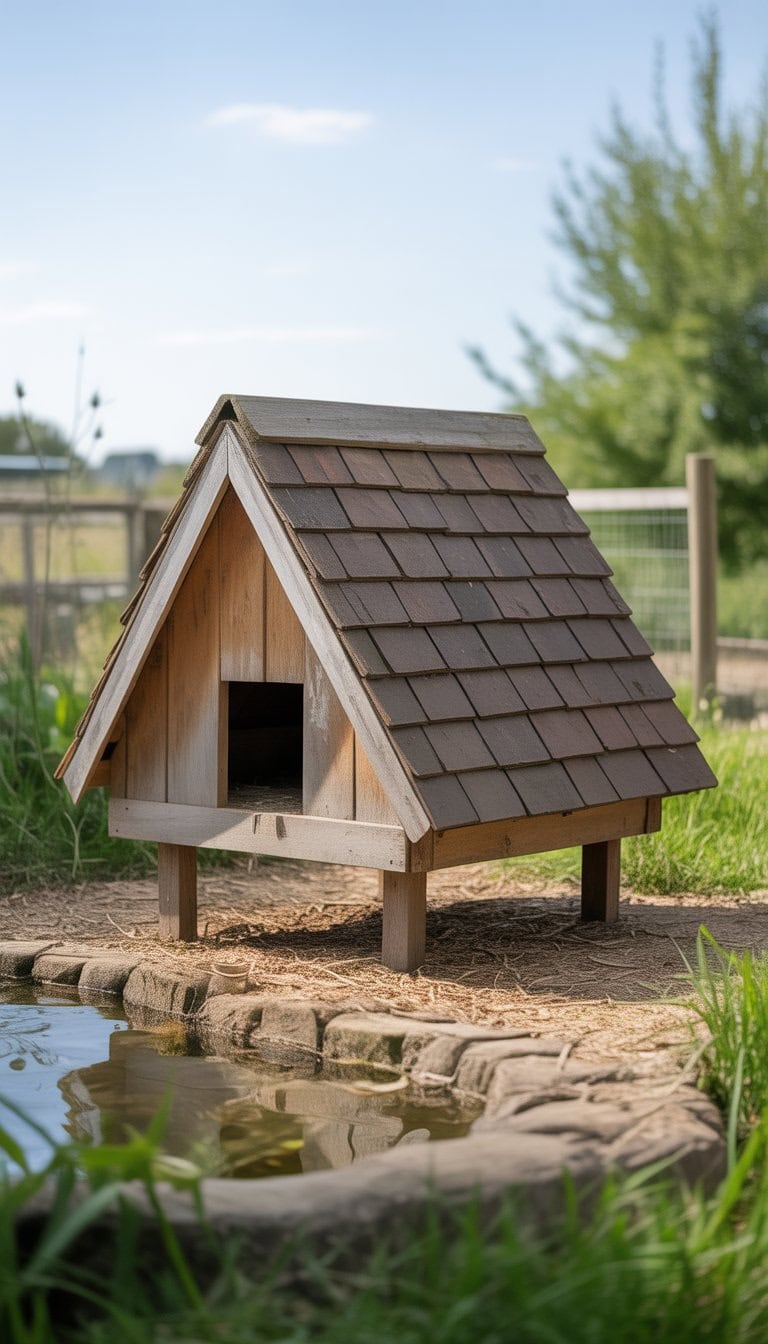
I love using the classic A-frame style for duck houses. It looks neat in my backyard and makes building easier for me. The sloped design keeps water running off, which helps keep ducks dry and comfortable.
When I added shingles to the roof, it made the house last longer against rain and wind. An A-frame like this can fit a small group of ducks and gives them plenty of room. For more details and ideas, I often look at this A-frame shingle roof duck house design.
Install a night door with hardware cloth for predator protection
I always make sure my ducks have a secure place to sleep at night. Adding a night door covered with hardware cloth keeps raccoons and other predators out.
Chicken wire isn’t enough for safety. I use sturdy hardware cloth and attach it tightly to the frame. It makes a strong barrier while letting the ducks get plenty of fresh air.
A simple latch and strong hinges help the door stay closed. For extra peace of mind, I also install a swivel lock. This setup gives me confidence that my flock will stay safe until morning.
Use treated 2x4s for the framing
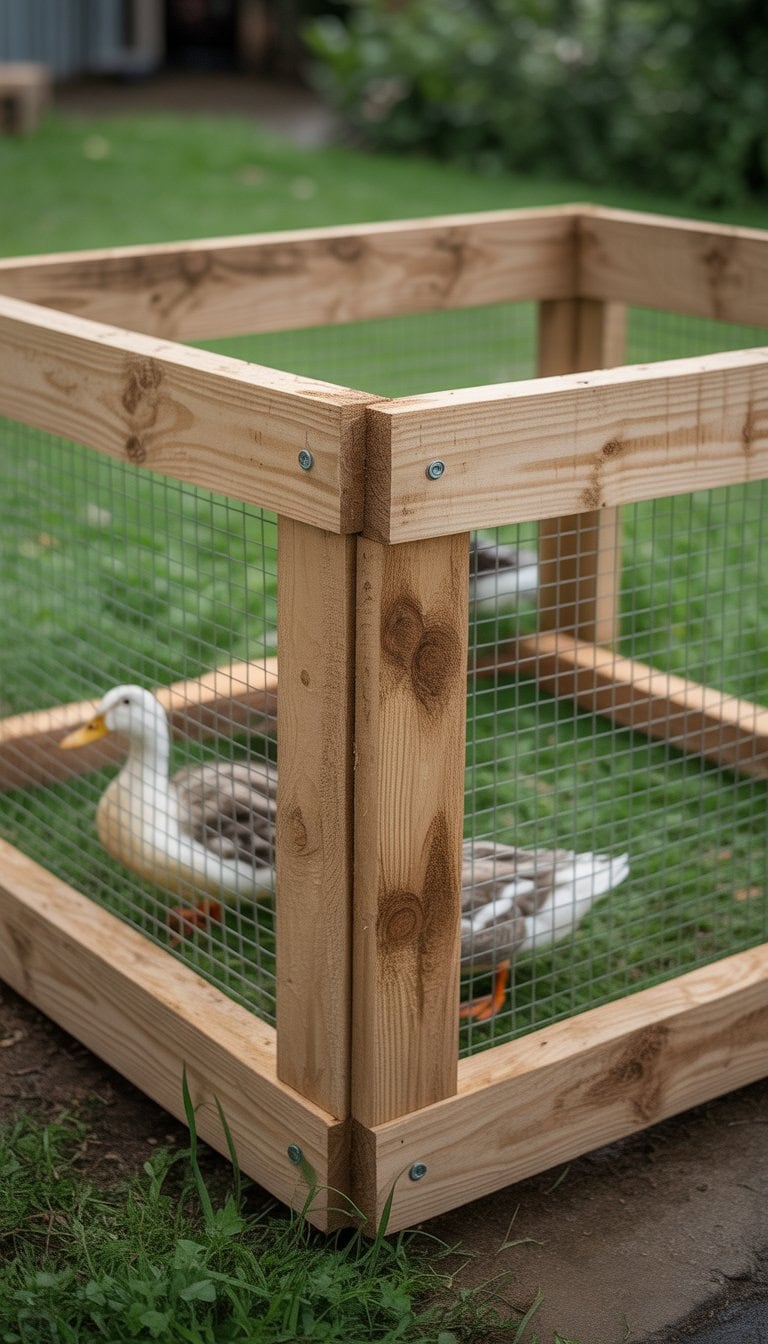
I always use treated 2x4s for my duck enclosure frames. They hold up well in wet weather and help keep the structure strong.
Treated wood lasts longer and helps protect against rot. This means less repair work for me down the road.
When I build with 2x4s, the frame feels steady and solid. I like knowing my ducks are safe and the pen won’t fall apart anytime soon.
Apply the deep litter method for floor cleaning
I always find the deep litter method makes duck coop cleaning easier and less stressful for me. To start, I spread a layer of bedding like straw or pine shavings about 3-4 inches thick across the floor.
When the bedding gets dirty, I just add another fresh layer on top. This saves me from doing a full cleanout every week. I turn the litter every week so it stays dry and reduces bad smells. For more tips, check out these ideas for using the deep litter method with ducks.
Set up a spray system to rinse the coop floor
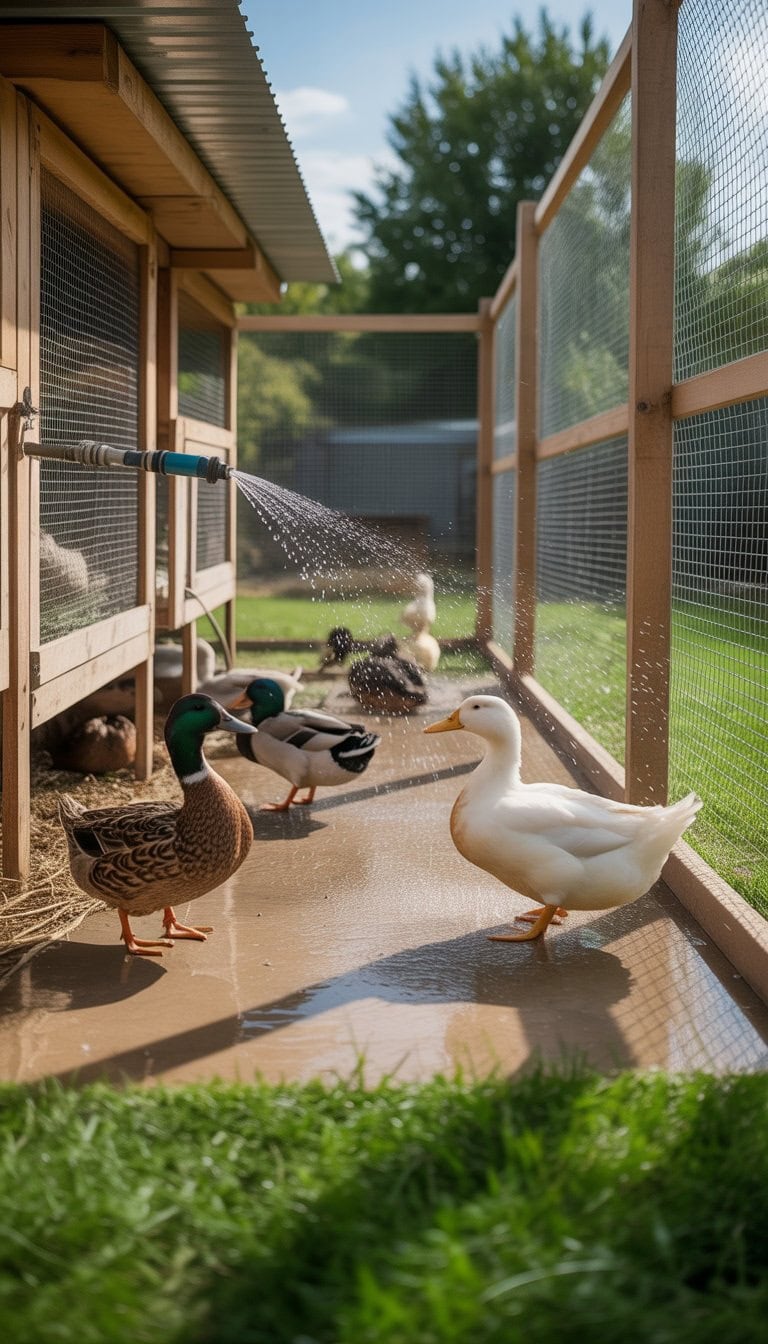
I love having a simple spray system in my duck coop. It lets me rinse away mess and mud without breaking a sweat.
I use a garden hose with a spray nozzle to quickly wash down the floor. A daily rinse keeps things cleaner and helps stop bad smells.
I’ve also seen some creative setups where people install misters or basic plumbing, making cleaning even easier. It’s one of my favorite hacks for keeping my ducks’ home tidy and fresh. If you’re curious about clean floor ideas, check out this DIY self-cleaning duck run.
Include at least 4 sq ft per duck inside the coop
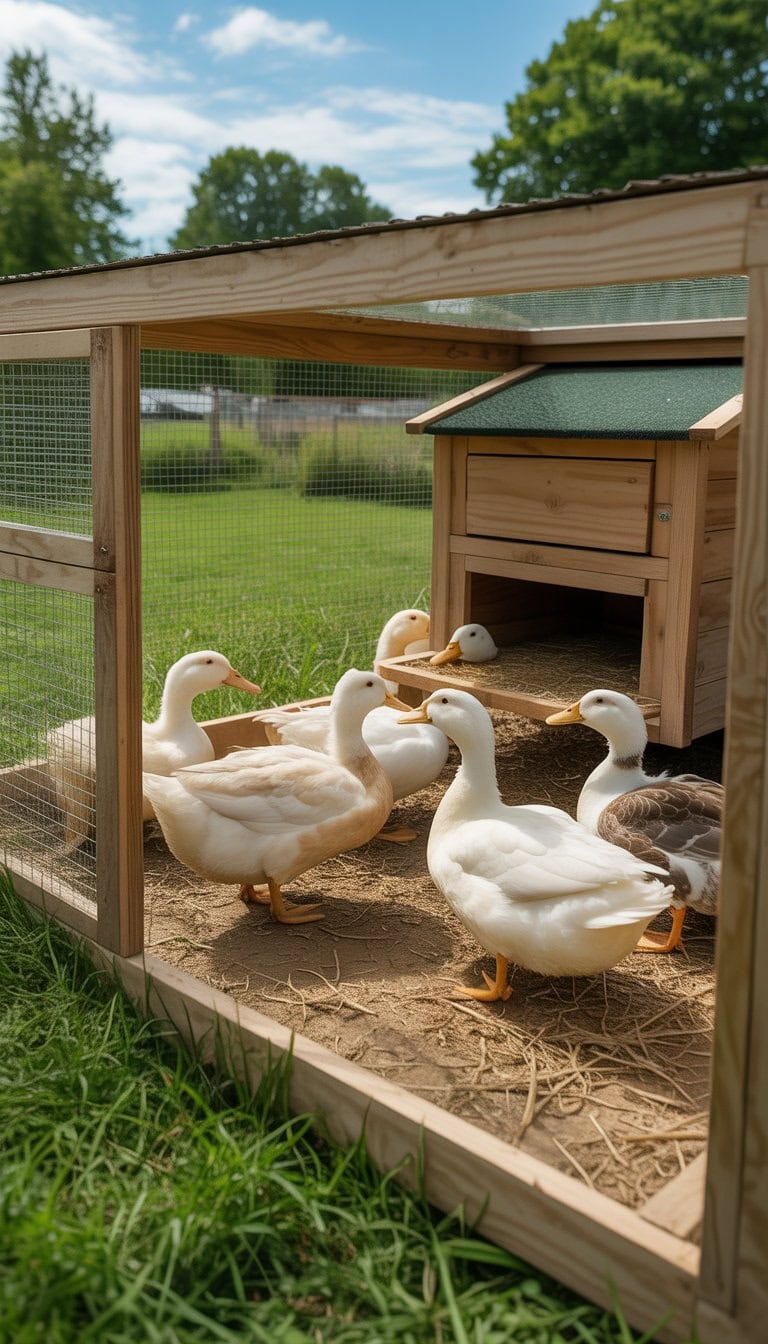
I always make sure each duck has at least 4 square feet of space inside the coop. This helps keep the ducks comfortable and reduces crowding. When I’m planning my design, I use this rule every time.
If you want happy and healthy ducks, this space really makes a difference. For more details, check out advice from experienced keepers who also use the 4 square feet per duck rule.
Convert a plastic playhouse into a duck shelter
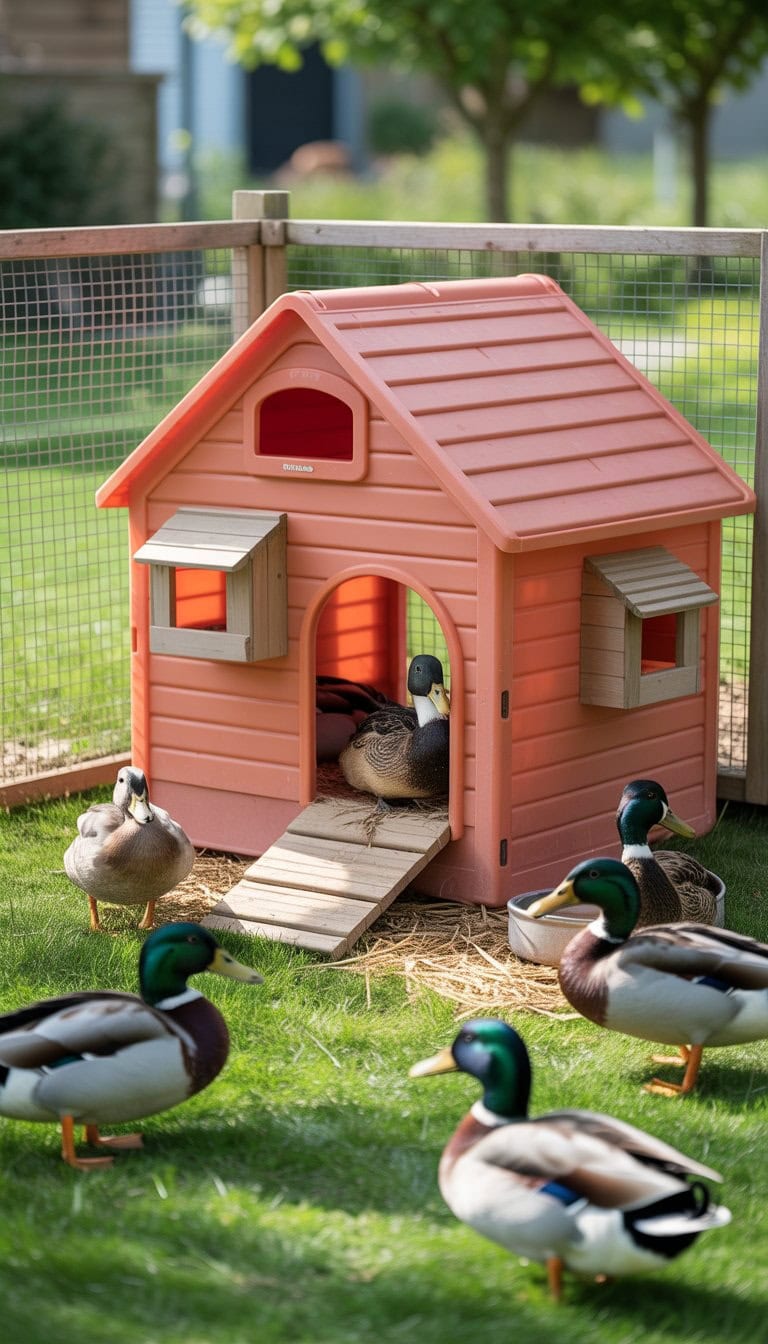
I found that a plastic playhouse can turn into a great duck shelter with just a few changes. The sturdy plastic keeps out rain and wind, which helps my ducks stay cozy.
I made sure to cover windows with wire mesh to stop any predators from getting in. Cleaning is also simple, since I can just hose down the inside.
I got this idea after seeing people repurpose playhouses for ducks. It’s a fun project and makes use of something many families already have around.
DIY self-cleaning duck run with sloped flooring
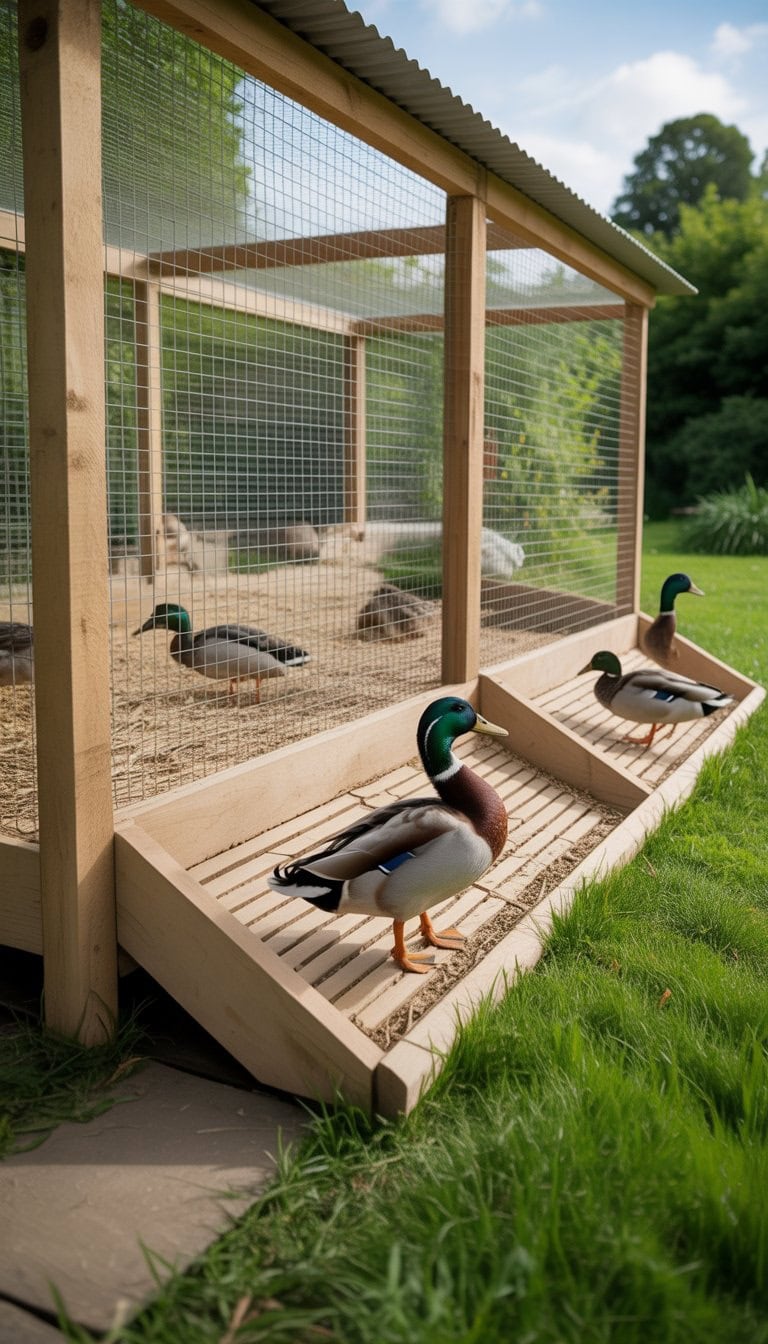
I found out that using a sloped floor in my duck run makes cleaning so much easier. When it rains, water moves the mess down the slope and out of the enclosure.
I built the floor with a gentle incline and made sure one side drains well. This helped keep mud and wet spots away from where the ducks spend most of their time.
Inspired by other easy self-cleaning duck runs, I used gravel to help with drainage. That way, most waste washes out, and less scooping is needed.
Add a small pond or water feature inside the enclosure
I always notice ducks are happiest when they have water to splash and swim in. That’s why I like to add a small pond or water feature to my duck enclosure. Even a simple plastic tub works if you don’t have space for a big pond.
When I built my pond, I tried using a pond liner to make it hold water better. It was easy to lay out and fold into the space I wanted. If you’re looking for ideas and tips, there are great DIY duck pond ideas online.
Use T-111 plywood for weather resistance
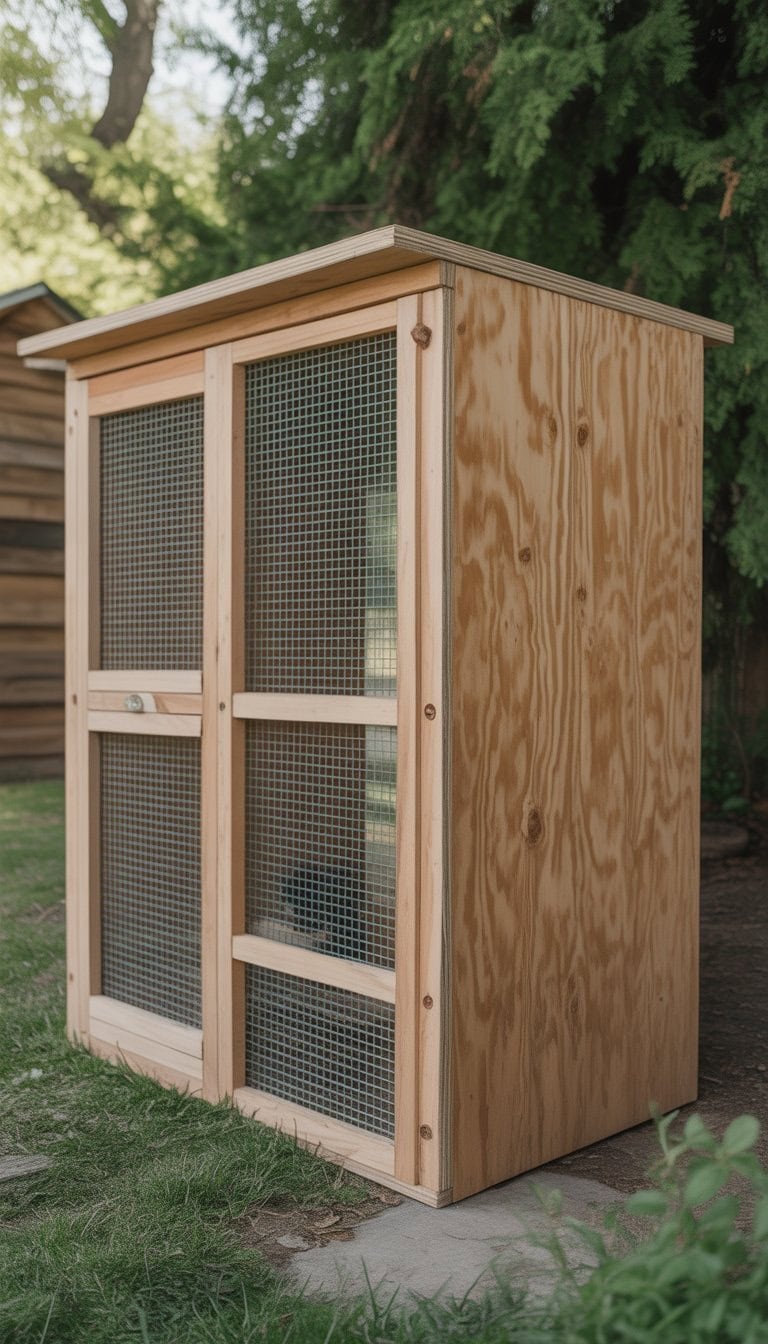
I like using T-111 plywood because it stands up well against rain and wind. It gives me peace of mind knowing my ducks stay dry during storms.
T-111 works better than regular plywood because it’s thicker and designed for the outdoors.
I’ve also found it’s easier to stain instead of paint. If you want a strong duck enclosure, T-111 is a smart choice. Check out more about T-111 in these helpful duck coop plans.
Build a half-exposed run area for sun and shade
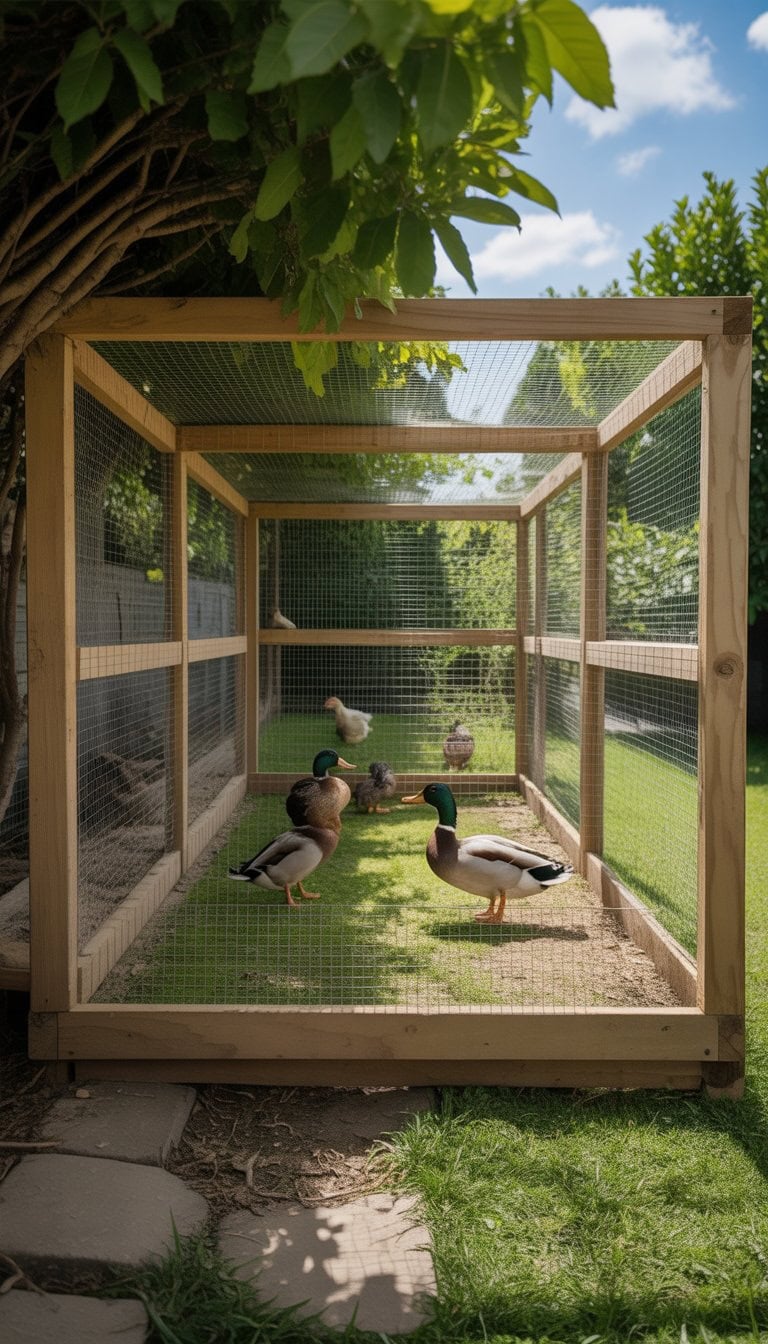
I like to make sure my ducks have choices. A half-exposed run lets them bask in the sun or cool off in the shade whenever they want.
I use a simple roof over one half, then leave the other side open to the sky. This setup keeps ducks happy and helps protect them from the weather.
It’s easy to build with basic tools and materials. For inspiration, I found more ideas from this DIY duck run guide.
Install hanging feeders to reduce mess
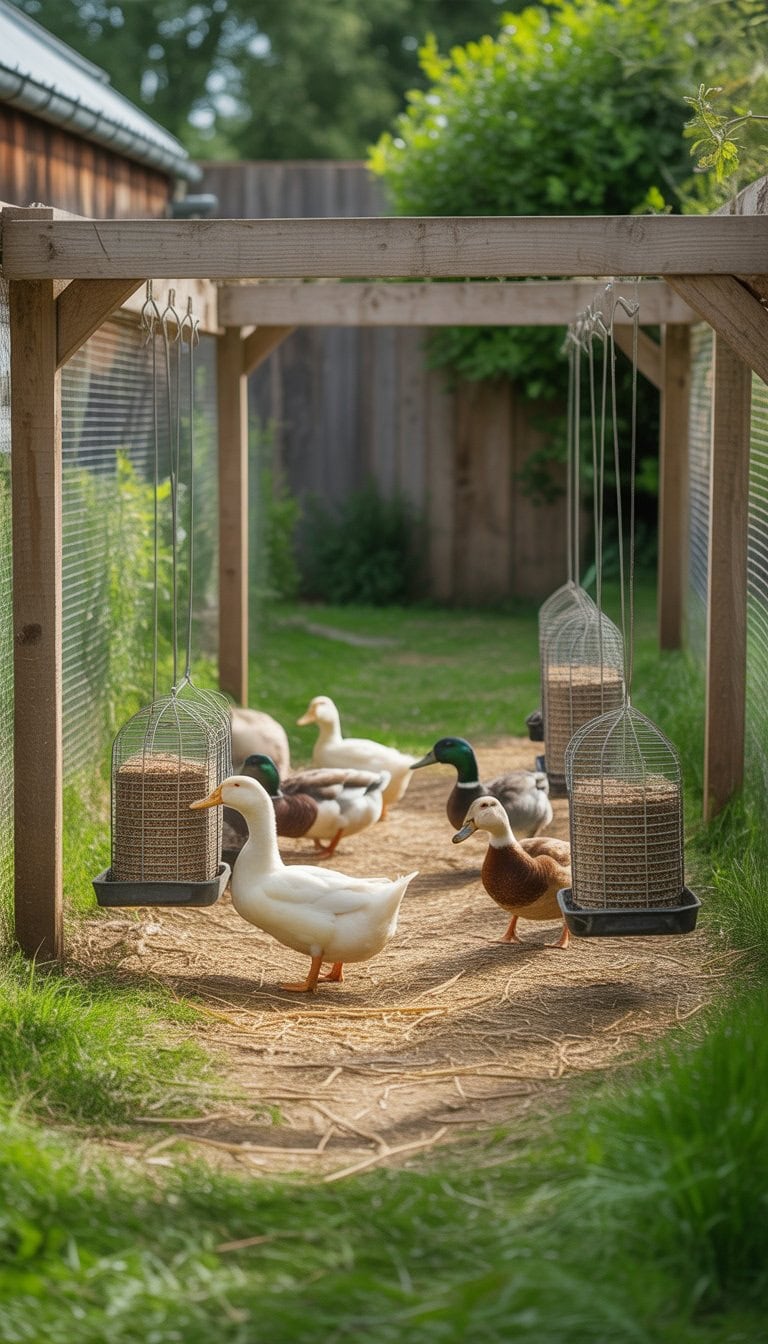
I used to deal with spilled duck feed everywhere until I tried hanging feeders in my duck enclosure. They’re simple to install and easy for my ducks to use.
When the feeder hangs at the right height, my ducks can’t kick or tip it over. This keeps most of the feed off the ground, which makes cleaning much faster.
I’ve found that a hanging feeder really does make feeding time smoother and keeps things tidier. If you want less waste and cleaner spaces, hanging feeders are worth a try. For more tips, check out this advice on mess-free duck feeders.
Create an easy-access door for daily maintenance
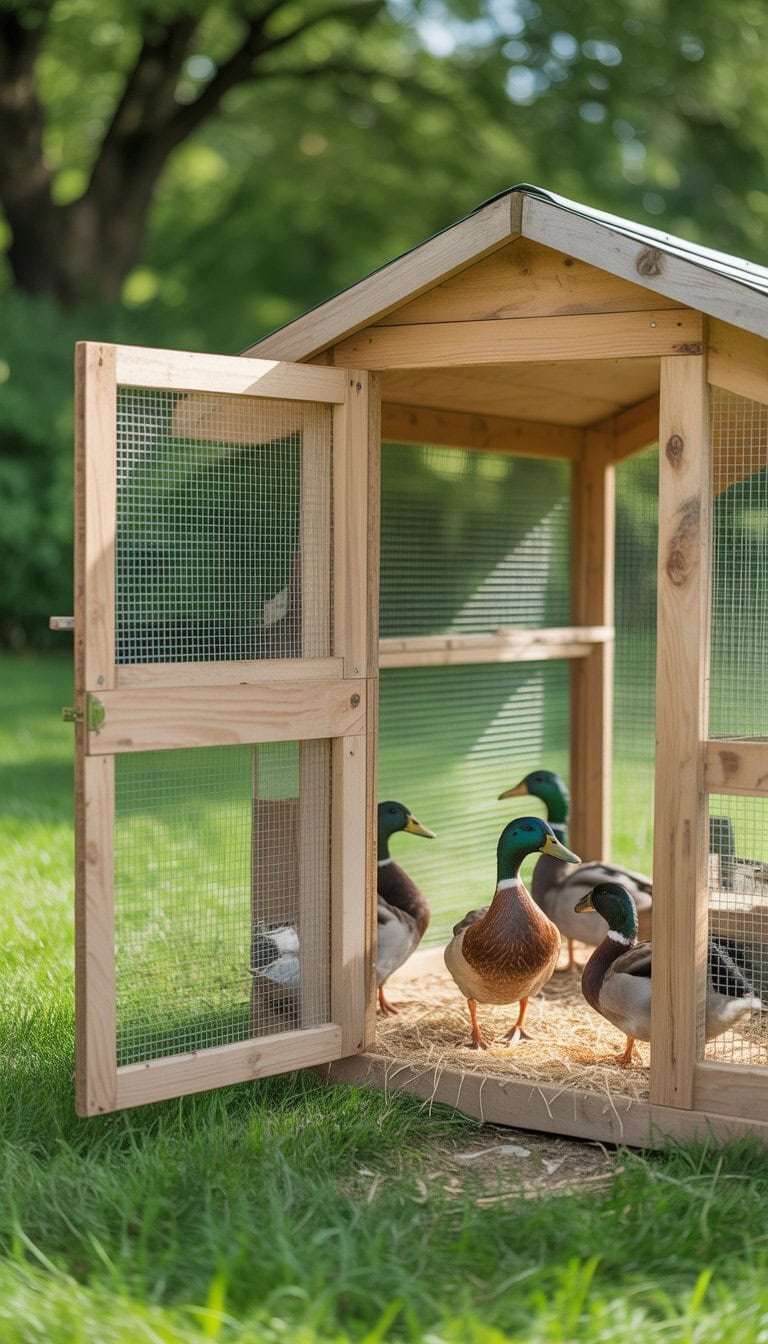
I like to keep duck chores quick and stress-free. That’s why I always add a door that’s wide enough for me to fit through with tools or feed.
A simple wooden frame, strong hinges, and a latch do the trick. I learned from building mine that it should swing out so I don’t get cornered inside.
For ideas on handy door builds, I found some helpful DIY guides for duck house doors. Even if you’re new to building, you can make it work!
Add a secure latch system to keep night predators out
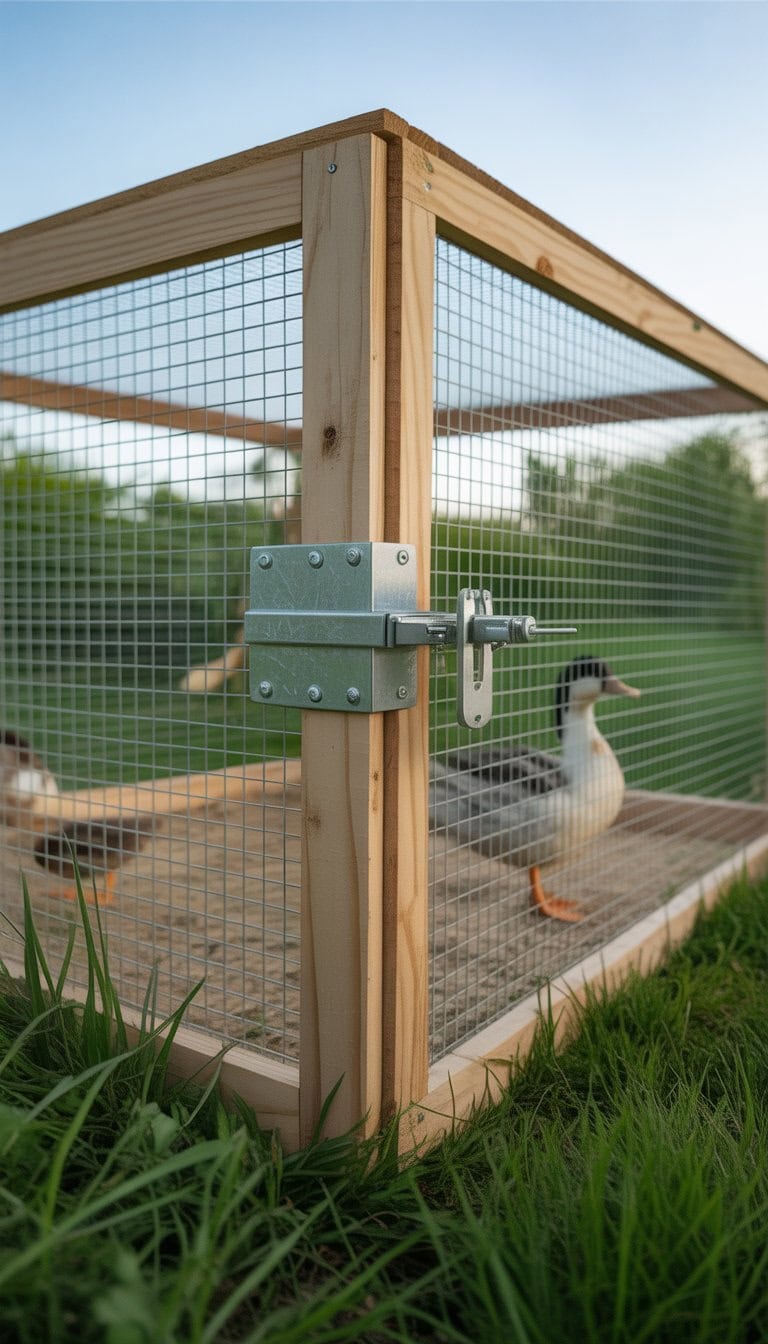
I always make sure my duck enclosures have a strong latch on every door and nesting box. Basic clips or loose hooks just won’t cut it for keeping out raccoons or neighborhood dogs.
After some trial and error, I found that a simple lock or sturdy twist latch gives peace of mind overnight. Many keepers also swap stories and ideas on which latch types work best for duck houses.
I never skip this step because a good latch can make all the difference.
Use wire mesh buried 12 inches underground to deter diggers
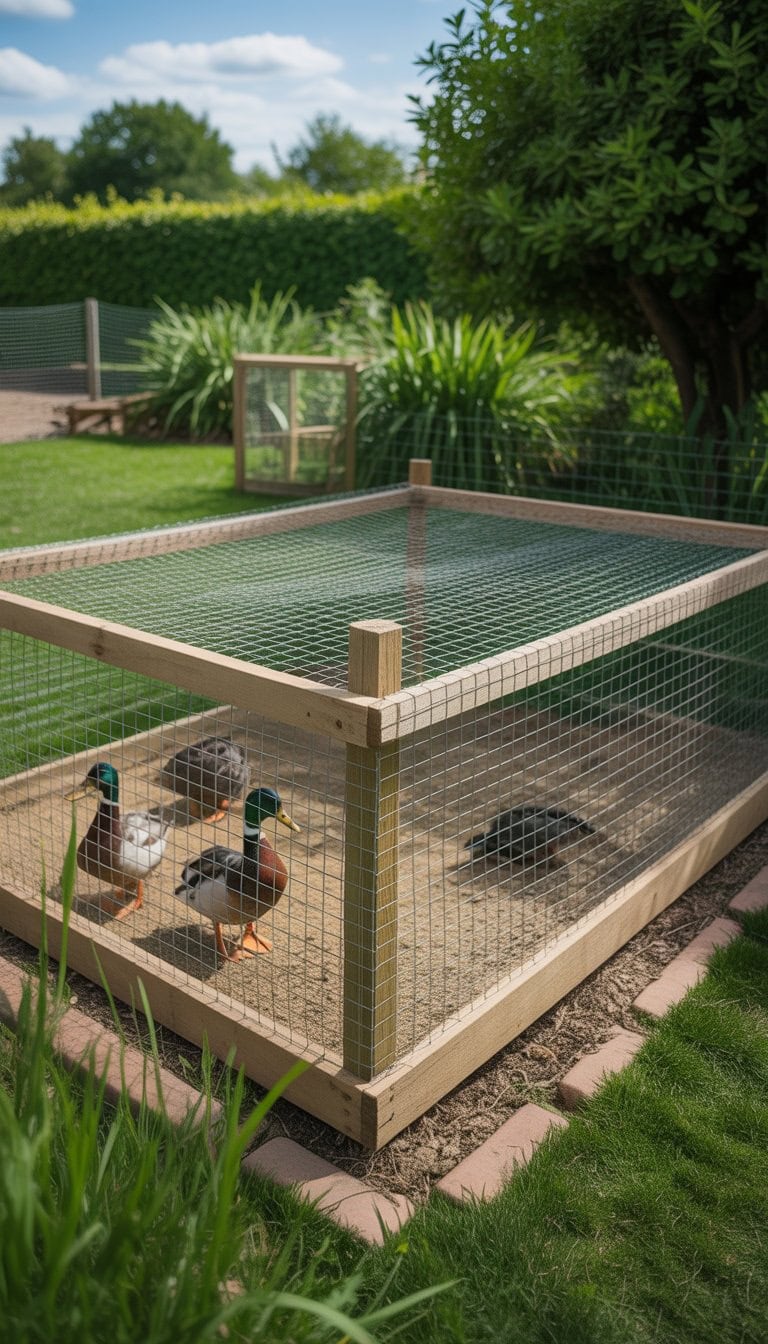
I’ve learned that predators love to dig under enclosures, so I always bury wire mesh at least 12 inches deep. This simple step keeps my ducks much safer.
I use strong hardware cloth or mesh, wrapping it around the outside of the pen. For even better protection, I extend the mesh out from each corner to block tricky spots, as suggested by experienced keepers in the Backyard Chickens community.
Incorporate nesting boxes inside the coop
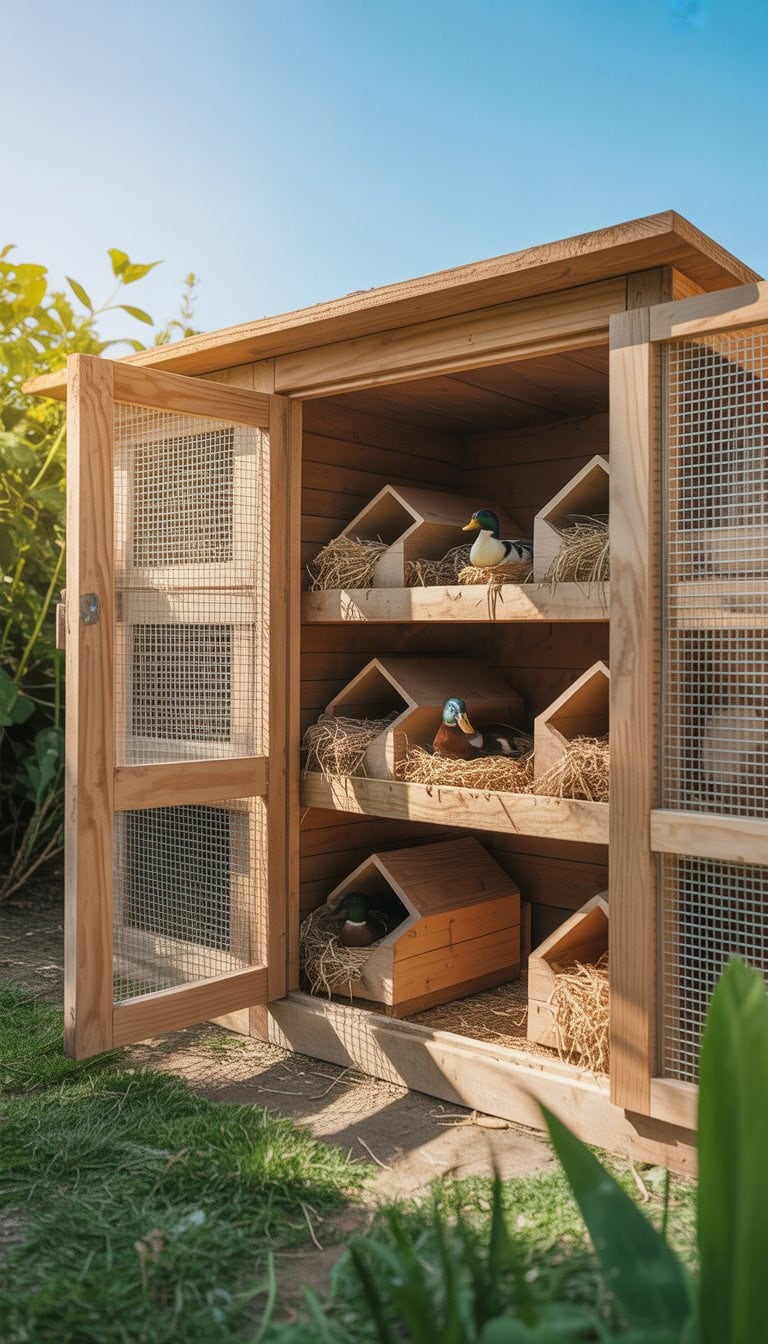
When I add nesting boxes inside my duck coop, I notice my ducks feel safer and lay eggs more often. Nesting boxes make it easier for me to keep eggs clean and easy to collect.
I like to use simple materials to make my own nesting boxes. It saves money and lets me choose the right size for my flock. There are plenty of easy ideas for duck nesting boxes that work well.
Build a portable duck enclosure for rotation
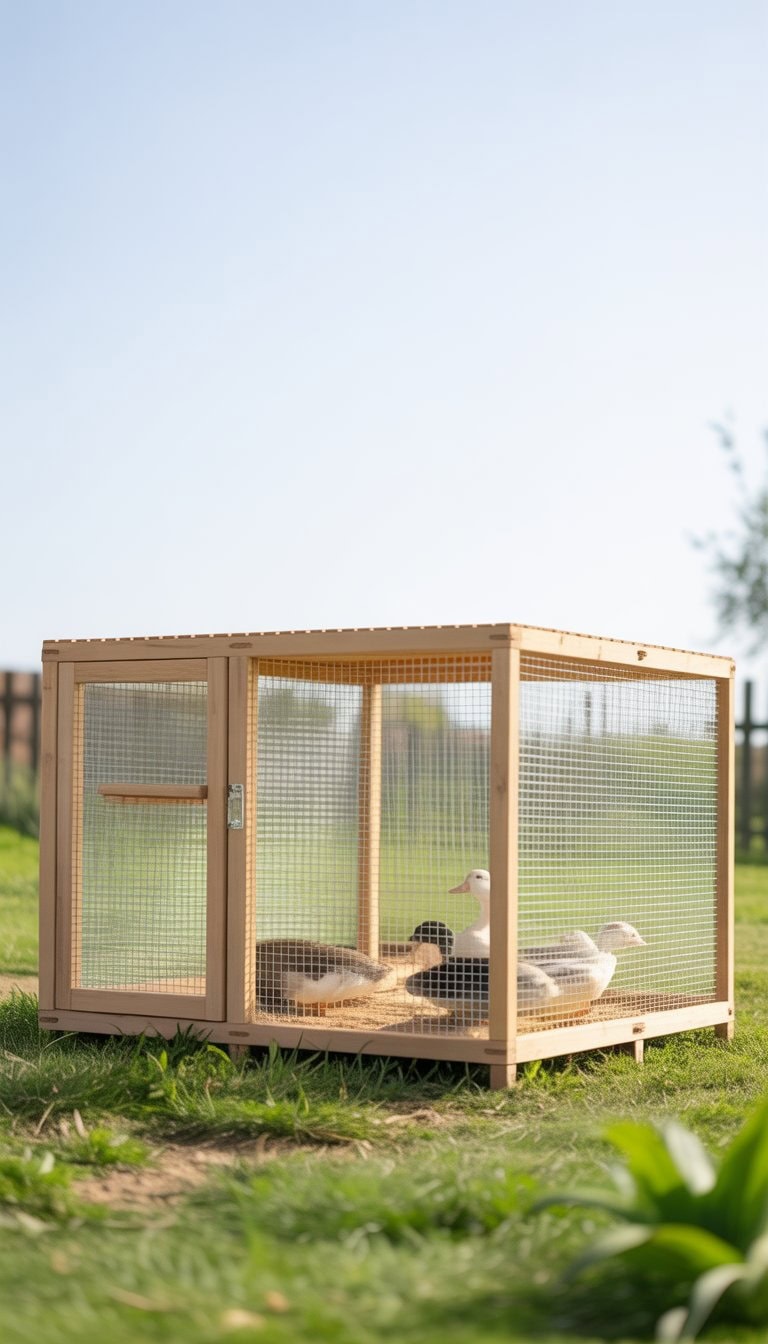
I really like using a portable duck enclosure because it keeps my ducks happy and helps the grass stay healthy. I can move it around the yard, so no spot gets too muddy or messy.
Building a portable duck house isn’t hard, either. I use lightweight materials and wheels to make it easier to pull. Knowing my ducks are safe from predators gives me peace of mind every night.
If you need ideas, I found a helpful discussion about a portable duck house that might inspire your own design.
Use recycled pallets for affordable fencing
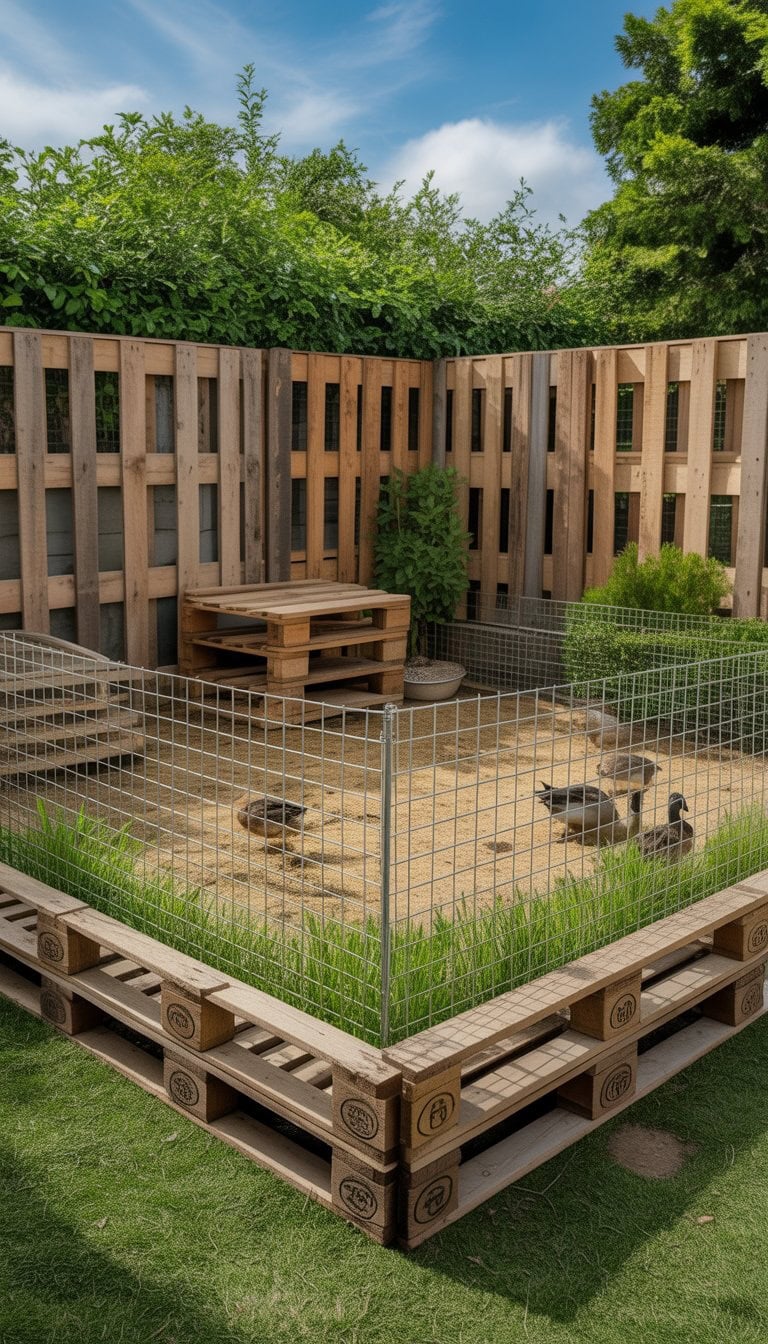
I love using recycled pallets because they save a lot of money and are easy to find. Pallets make sturdy fences for duck enclosures, and I don’t need fancy tools to work with them.
When I build with pallets, I get to reuse old wood and help the environment. I often find pallets at hardware stores or online for free.
For even more ideas, I check out duck enclosures made with pallets and chicken wire on TikTok.
Attach a simple rainwater collection system
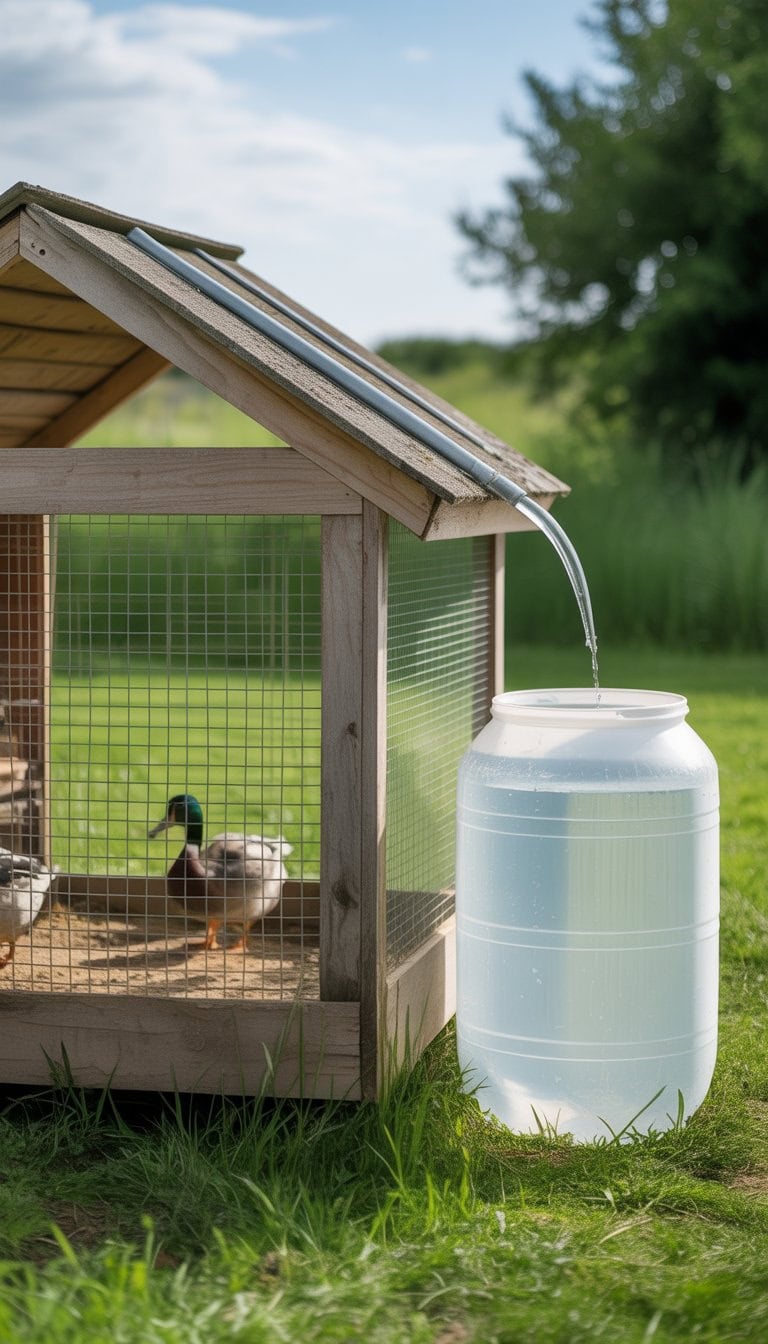
I love making my duck care easier, so I attached a basic rainwater collection system. I started by putting gutters along the roof of my duck enclosure.
The rainwater runs into a barrel with a screen to keep out leaves and bugs. I use this water to fill my ducks’ pond and bowls, and it saves me time and effort.
If you want ideas on setting up your own, you can check out a step-by-step DIY rainwater collection system or see how others connect gutters to barrels for their duck coop.
Place elevated perches for resting ducks
I always add a few raised perches in my duck enclosures. While ducks don’t roost like chickens, they still enjoy having a clean, dry spot to rest off the ground.
I use wide boards or low platforms, only about 8-12 inches off the ground. Ducks need enough space to walk up, and I keep it sturdy for their webbed feet.
Adding these perches gives ducks more options and keeps them comfortable, especially when the ground is wet. It also helps their feet stay healthy and dry.
Essential Elements For Duck Safety
When I create a duck enclosure, keeping my flock safe from harsh weather and hungry predators is always my top concern. Planning ahead saves me from headaches, and helps my ducks stay healthy and happy all year long.
Weatherproofing And Shelter Tips
I’ve learned that ducks handle cold better than heat, but they need a dry, draft-free place to rest. A sturdy, leak-proof roof keeps rain from soaking their bedding and helps prevent mold. For those of us who get snow, adding a solid roof can stop the enclosure from collapsing under the weight, and it keeps ducks comfortable during storms.
When the temperature drops, insulation helps, but good airflow is still important—I use small vents up high to let out moisture without making it drafty. Elevating the shelter a few inches off the ground helps keep the floor dry. If I use cement bricks for flooring, covering them with plastic boards or wood makes cleaning much easier and keeps feet warm. In hot weather, providing shade and lots of fresh water keeps ducks from overheating.
I often add a small tarp or removable side panels for extra wind protection in the coldest months. The right materials make a huge difference in my ducks’ comfort and safety. For detailed duck run design tips, I found a step-by-step guide especially helpful at DIY duck run.
Predator Protection For Peace Of Mind
Nothing is worse than losing a duck to a fox or raccoon, so building strong defenses is key for me. I use welded wire fencing with holes smaller than an inch to keep out digging and climbing predators. I always dig the fencing at least a foot underground to deter diggers.
A secure roof, even just chicken wire, stops aerial threats like hawks and owls. At night, I lock my ducks inside a coop with solid doors and latches that raccoons can’t open. For extra peace of mind, I install motion-activated lights or cameras around the enclosure.
Keeping the run mess-free helps too—leftover food attracts pests. I’ve seen clever designs using bricks and boards for floors, making it easy to hose down and clean up spills fast. Regular checks for weak spots or gaps are a must. More tips on safe, secure duck habitats can be found at Habitat and Housing for Ducks.
Maintaining And Upgrading Your DIY Duck Enclosure
Keeping my duck enclosure nice and functional is the key to happy, healthy ducks. Staying on top of cleaning makes chores easier, and a few smart upgrades each season can save stress and money.
Cleaning Strategies That Actually Work
I learned quickly that messy duck runs are tough, but a few tricks make things easier. Using a gravel or sand base keeps mud at bay and helps with drainage, which means my shoes stay clean and the ducks stay dry. For floor cleaning, I like to use a sturdy rake and a large dustpan.
For wet areas or under water sources, I found putting a slatted wooden platform lets water drain while poop dries on top, reducing stink and mess. Setting up a self-cleaning system that uses gravity and rainwater makes chores even faster if you have the space and tools.
Here are my regular cleaning steps:
- Remove leftover food daily
- Rake up bedding or droppings
- Refresh water and clean bowls
- Check for standing water and scoop it away
Once a week, I do a bigger clean with a hose and gentle disinfectant where needed. If you want more ideas, people share lots of tips for keeping a duck pool clean and easy to maintain too.
Seasonal Adjustments And Enhancements
I like to change up my duck enclosure as the weather shifts, especially for safety and comfort. In the winter, I add thicker straw bedding to keep my ducks warm and check that the house blocks drafts. Sometimes I use old materials, like a repurposed cover for the roof to keep rain out—ideas like these are easy to find in online DIY duck enclosure guides.
When it gets hot, I put up extra shade cloths and make sure there’s a steady supply of clean water. I try to give extra water tubs or a misting system when it’s especially warm. In every season, I keep an eye out for gaps or weak spots in the fence and patch them before any trouble starts.
Here’s what I always check and tweak each season:
| Season | What I Add or Change |
|---|---|
| Winter | More bedding, weatherproofing barriers |
| Summer | Shade cloths, extra water, improve airflow |
| Spring/Fall | Check structure, patch gaps, refresh bedding |
I enjoy this routine because it keeps my ducks safe and gives me a chance to upgrade the space.
Frequently Asked Questions
Building a duck enclosure brings up all kinds of practical and creative challenges. I’ve gotten lots of questions about how to design, protect, clean, and decorate these spaces so ducks stay happy and healthy.
How can I build a duck enclosure that accommodates a growing flock?
I always start with more space than I think I need. Ducks love to roam, and a 300 sq ft coop with strong fencing lets me add more ducks later. If my flock does grow, adding movable partitions or easy-to-build extensions keeps everything safe and organized.
What DIY tips can I apply to create a cozy and easy-to-clean duck house?
Using pine bedding has saved me a ton of cleaning time. I make sure to pick bedding that soaks up moisture but is easy to scoop out. For coziness, I place the duck house under a covered area to help with rain and snow. Quick-release latches make cleaning the floor simple.
Wondering about the perfect materials for a sturdy and weatherproof duck shelter?
I like to use wood, hardware cloth, and shingles. An A-frame shingle roof duck house stands up to rough weather. For siding, treated wood holds up best in wet areas. I cover openings with wire mesh to stop predators and still allow fresh air.
What’s the ideal way to ensure proper ventilation in my homemade duck enclosure?
I always add vents at the top of the enclosure walls well above the bedding line. Cross-ventilation is key, so I space vent holes on opposite sides. If possible, I place mesh-covered windows so air moves freely but drafts don’t hit my ducks directly.
Could you suggest creative themes for designing an engaging duck habitat on a budget?
Turning old plastic playhouses or wooden pallets into duck houses has worked well for me. I sometimes paint the outside with weather-safe colors to make it more cheerful. Hanging up a few cheap planters or repurposing garden items creates fun spaces for ducks to explore, just like these DIY duck enclosure ideas.
Challenged by limited space? How can you maximize it for a functional duck haven?
Raising the duck house on a pallet base lets me use the space underneath for shelter or storage. I use vertical racks for food and water. A covered run can double as a sun and rain shelter, making every square foot count. I often look at how others fit enclosures in small backyards for clever space-saving tricks.